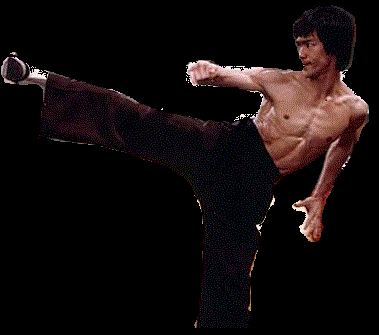Kyokushin
Kyokushin kaikan (極真会館) is a face of stand-up, full contact karate, founded in 1964 by Korean-Japanese karate master, Sosai Masutatsu Oyama (大山倍達 Ōyama Masutatsu?) who was born under the name Choi Young-Eui. 최영의}. Kyokushinkai is Japanese for "the society of the ultimate truth". Kyokushin is rooted in a philosophy of self-improvement, discipline and hard training. Its full contact style has had international appeal (practitioners have over the last 40+ years numbered more than 12 million).
Origin
The following is a brief overview of the early life of Masutatsu "Mas" Oyama.
The founder of International Karate Organization Kyokushinkaikan, Masutatsu Oyama, was born Choi Bae Dal in 1923 on July 27, during the Korea under Japanese rule.
As a young child, Oyama enjoyed fighting and watching others fight. His childhood was spent in Manchuria, China where he learned Kempo (Chuan'Fa/18 Hands Techniques) from a Chinese seasonal worker named Lee. Oyama refers to Lee as his first teacher.
In 1938, he emigrated to Japan and studied Okinawan Karate under Gichin Funakoshi, eventually gaining 2nd dan. Later, Oyama also trained under Yoshida Kotaro, a famous Daito-ryu Aiki-jujutsu/Yanagi-ryu Aiki-jujutsu master, from whom he received his menkyo kaiden – an older form of grade, a scroll signifying mastery. This scroll is still on display at the honbu (headquarters) dojo in Tokyo.
Also, upon the advice of his mentor and a member of the National Diet, Matsuhei Mori, around this time the young master took his Japanese name, Masutatsu Oyama, the name he would use for the rest of his life. After World War II, Oyama began his training in Goju Ryu karate under a Japanese master in Japan, So Nei Chu, who ran a dojo in Tokyo with the famous goju teacher Gogen Yamaguchi. He would finally attain 8th Dan in Goju Ryu Karate. Another influence from the Goju school was Masahiko Kimura. Although fulfilling the role of assistant karate instructor at the dojo Oyama trained at, Kimura was primarily a famous champion of judo, who defeated Hélio Gracie of Brazilian Jiujitsu (aka. Jujitsu) fame. Kimura encouraged Oyama to take up judo so that he would have an understanding of the art's ground techniques. Kimura then introduced Oyama to the Sone Dojo in Nakano, Tokyo, where he trained regularly for four years, eventually gaining his 4th Dan in this discipline.
It was after this time that Oyama first retreated into the mountains for one of his well-known solitary training periods, the so-called yamagomori. He undertook two such retreats lasting a total of almost three years, in accordance with the ascetic traditions of many of the great warriors of Japan through the centuries. During these periods of isolated retreats spent in training, Oyama engaged in intense shugyo, or spiritual discipline.
In the early 1950s, Oyama traveled to the USA visiting 32 states.
Founder:
Founder of Kyokushin Karate, Masutatsu Oyama.
In 1953, Oyama resigned from Goju ryu and opened his own independent karate dojo, named "Oyama Dojo" in Tokyo, but continued to travel around Japan and the world, giving martial arts demonstrations (including bare-hand challenges).[citation needed] His first "Oyama dojo" was a vacant lot in Mejiro, Tokyo. In 1956, he moved the dojo into the ballet studio attached to Rikkyo University. Oyama's own curriculum soon developed a reputation as a tough, intense, hard-hitting, and practical style which he named "Kyokushin" in a ceremony in 1957. As the reputation of the dojo grew, students were increasingly attracted by the opportunity to train there, arriving from across Japan and beyond, and their numbers continued to grow.
In 1964, Oyama moved the dojo into a building he refurbished, not far from the ballet studio at Rikkyo. Oyama also formally founded the "International Karate Organization Kyokushinkaikan" (commonly abbreviated to IKO or IKOK), in order to organize the many schools that were by then teaching Kyokushin Karate.
1964 to 1994:
After formally establishing the Kyokushinkaikan, Oyama directed the organization through a period of expansion. Oyama hand-picked instructors who displayed ability in marketing the style and gaining new members. Oyama would choose an instructor to open styles in another town or city in Japan. The instructor would move to that town and usually demonstrate his karate skills in public places, such as at the civic gymnasium, the local police gym (where many judo students would practice), a local park, or conduct martial arts demonstrations at local festivals or school events. In this way, the instructor would soon gain students for his new dojo. After that, word of mouth would spread through the local area until the dojo had a dedicated core of students. Oyama also sent instructors to other countries such as the Netherlands (Kenji Kurosaki), Australia (Shigeo Kato), the United States of America (Tadashi Nakamura, Shigeru Oyama and Yasuhiko Oyama, Miyuki Miura) and Brazil (Seiji Isobe) to spread Kyokushin in the same way. In addition, numerous students began to travel to Japan to train with Oyama, consequently returning to their country to spread the art. In 1969, Oyama staged The First All-Japan Full Contact Karate Open Championships which took Japan by storm and Terutomo Yamazaki became the first champion. All-Japan Championships have been held at every year. Also in 1975, The First World Full Contact Karate Open Championships were held in Tokyo. World Championships have been held at four-yearly intervals since.





